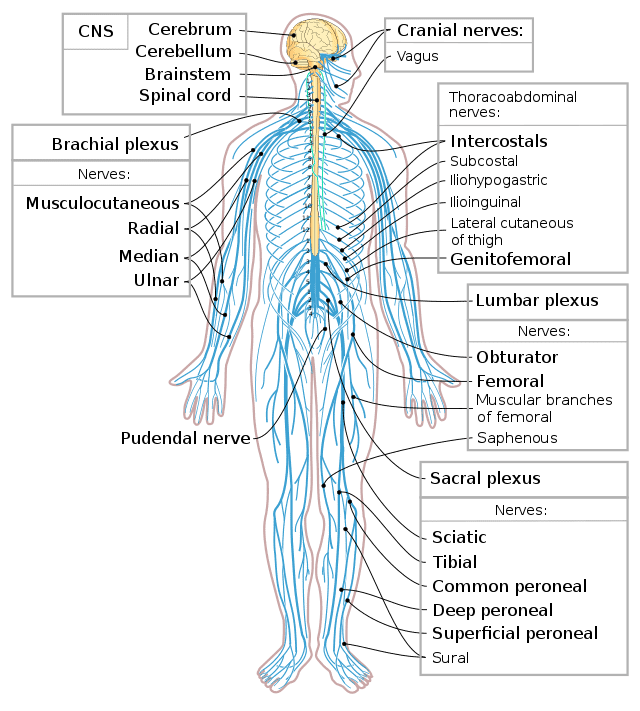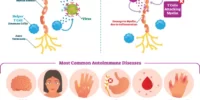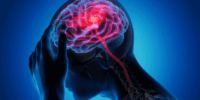Central And Peripheral Nervous Systems Explained

The nervous system is one of the most complex and intricate systems in the human body. It is responsible for controlling and coordinating all bodily functions, including movement, sensation, perception, and cognition.
The nervous system is divided into two main parts: the central nervous system (CNS) and the peripheral nervous system (PNS). The CNS consists of the brain and spinal cord, while the PNS includes all the nerves that extend from the CNS to the rest of the body.
The PNS is further divided into two parts: the somatic nervous system and the autonomic nervous system. The somatic nervous system controls voluntary movements, such as those involved in walking and talking, while the autonomic nervous system regulates involuntary functions, such as breathing, heart rate, and digestion.
Understanding the anatomy and functions of the central and peripheral nervous systems is essential for diagnosing and treating neurological disorders and injuries.
Key Takeaways
- The nervous system is divided into the central and peripheral nervous systems.
- The PNS is further divided into the somatic and autonomic nervous systems.
- The autonomic nervous system is divided into the sympathetic and parasympathetic divisions responsible for the fight-or-flight and rest-and-digest responses, respectively.
- Sensory neurons collect information and relay it to the CNS for processing, while motor neurons send signals from the CNS to muscles and glands for the appropriate response.
An Overview of the Nervous System
The nervous system can be broadly categorized into two main divisions, the central nervous system and the peripheral nervous system, which play critical roles in regulating and coordinating the functions of the body’s various organ systems.
The central nervous system, which includes the brain and spinal cord, serves as the main control center for the body. It receives and processes information from the peripheral nervous system and sends out appropriate responses to maintain homeostasis and respond to external stimuli.
The peripheral nervous system, on the other hand, consists of all the nerves that connect the central nervous system to the rest of the body. It is further divided into two subdivisions called the somatic nervous system and the autonomic nervous system.
The somatic nervous system controls voluntary movements and receives sensory information from the body’s surface and skeletal muscles. The autonomic nervous system, on the other hand, regulates involuntary functions such as heart rate, blood pressure, digestion, and respiration.
Understanding the differences and interactions between the central and peripheral nervous systems is crucial for understanding how the body functions and how it responds to changes in the environment.
The Central Nervous System: Brain and Spinal Cord
Comprising the cranial and spinal nerves, the central nervous system is responsible for receiving sensory information and transmitting motor commands to the rest of the body. The brain and spinal cord are the two primary components of the central nervous system. The brain is the center of all mental activity, controlling various body functions, such as breathing, heart rate, and digestion. It is also responsible for conscious activities such as memory, learning, and decision-making. The spinal cord, on the other hand, acts as a highway for communication between the brain and the rest of the body. It is responsible for transmitting sensory information from the body to the brain and motor commands from the brain to the muscles.
To further understand the functions of the central nervous system, it is essential to consider its role and the impact of damage to this system. The table below summarizes the key functions of the central nervous system and the effects of damage to this system. Damage to the central nervous system can result in various conditions, such as paralysis, speech and language disorders, and cognitive impairments. It can also lead to conditions such as Parkinson’s disease, which affects motor control, and Alzheimer’s disease, which affects memory and cognitive function. Understanding the central nervous system and its impact can help improve the diagnosis, treatment, and management of various neurological conditions.
| Function | Effects of Damage | |||
|---|---|---|---|---|
| Sensory processing | Loss of sensation | |||
| Motor control | Paralysis | |||
| Memory and learning | Cognitive impairments | |||
| Decision-making | Impaired judgment | |||
| Autonomic function | Breathing difficulties | |||
| Speech and language | Speech and language disorders | Emotional regulation | Emotional dysregulation and mood disorders |
The Peripheral Nervous System: Nerves and Ganglia
Consisting of nerves and ganglia, the peripheral nervous system plays a crucial role in transmitting sensory and motor information between the central nervous system and the rest of the body.
Nerves in the peripheral nervous system are classified based on their function and location. Sensory nerves, also known as afferent nerves, carry information from the sensory receptors in the body to the central nervous system. Motor nerves, also known as efferent nerves, carry information from the central nervous system to the muscles and glands in the body. Lastly, mixed nerves contain both sensory and motor fibers and are responsible for transmitting information in both directions.
Ganglia are clusters of nerve cells located outside of the brain and spinal cord. They are found along the length of the nerves in the peripheral nervous system and contain the cell bodies of sensory and autonomic neurons.
The autonomic nervous system, which is responsible for controlling involuntary actions such as heart rate and digestion, is divided into sympathetic and parasympathetic divisions. The sympathetic division, also known as the fight or flight response, is responsible for increasing heart rate and blood pressure in response to stress. The parasympathetic division, also known as the rest and digest response, is responsible for slowing down heart rate and increasing digestion.
Overall, the peripheral nervous system is essential for transmitting information between the brain and the rest of the body, allowing for proper sensory and motor function.
Sensory and Motor Functions of the PNS
Understanding the sensory and motor functions of the nerves and ganglia in the peripheral nervous system is crucial for comprehending how the body interacts with the environment.
The sensory function of the PNS is responsible for detecting both internal and external stimuli. This includes a wide range of sensory modalities such as touch, temperature, pain, pressure, and proprioception.
The sensory neurons in the PNS are responsible for collecting this information and relaying it to the central nervous system for processing. This allows the brain to generate an appropriate response to the stimulus, whether it is to move away from a painful stimulus or to adjust body posture to maintain balance.
On the other hand, the motor function of the PNS is responsible for controlling the muscles and glands in response to the sensory input. The motor neurons in the PNS are responsible for sending signals from the central nervous system to the muscles and glands to produce an appropriate response.
This can include anything from the contraction of skeletal muscles for movement to the secretion of hormones into the bloodstream. Overall, the sensory and motor functions of the PNS work together to allow for the proper functioning of the body in response to the environment.
To further illustrate the importance of the sensory and motor functions of the PNS, consider the following list of examples:
- When you touch a hot stove, the sensory neurons in your skin detect the heat and send a signal to your spinal cord.
- The spinal cord processes this information and sends a signal through motor neurons to the muscles in your arm, causing it to move away from the hot stove.
- When you hear a loud noise, the sensory neurons in your ear detect the sound and send a signal to your brain.
- The brain processes this information and sends a signal through motor neurons to the muscles in your body, causing you to react appropriately, such as jumping or turning around.
These examples demonstrate how the sensory and motor functions of the PNS work together to allow for the appropriate response to the environment. Without these functions, the body would be unable to interact with the world around it in a meaningful way.
The Autonomic Nervous System: Sympathetic and Parasympathetic Divisions
The autonomic nervous system is responsible for regulating involuntary bodily functions, such as heart rate and digestion, through the sympathetic and parasympathetic divisions. The sympathetic division is responsible for the fight-or-flight response, which prepares the body for action in response to a perceived threat. This response includes increased heart rate, dilation of the pupils, and increased blood pressure. It also inhibits digestion and increases blood sugar levels, providing the body with energy to respond to the potential threat.
On the other hand, the parasympathetic division is responsible for the rest-and-digest response, which allows the body to conserve energy and focus on digestion and other restorative processes. This response includes slowing the heart rate, constricting the pupils, and decreasing blood pressure. It also promotes digestion and lowers blood sugar levels. The sympathetic and parasympathetic divisions work together to maintain balance and homeostasis in the body, responding to internal and external factors to ensure the body functions properly. The following table summarizes the differences between the two divisions of the autonomic nervous system:
| Sympathetic Division | Parasympathetic Division | |
|---|---|---|
| Response to Stress | Fight-or-Flight | Rest-and-Digest |
| Heart Rate | Increases | Decreases |
| Pupils | Dilate | Constrict |
| Blood Pressure | Increases | Decreases |
| Digestion | Inhibited | Promoted |
| Blood Sugar Levels | Increases | Decreases |
Understanding the differences between the sympathetic and parasympathetic divisions is crucial in understanding how the autonomic nervous system affects various bodily functions. By maintaining a balance between these two divisions, the body can effectively respond to stress and conserve energy, ensuring optimal health and well-being.
Neurons and Neurotransmitters
Neurons are the fundamental units of the nervous system responsible for transmitting information between different parts of the body. They are specialized cells that have a unique structure and function.
Neurons are composed of three main parts, including the cell body, dendrites, and axon. The cell body contains the nucleus and other organelles responsible for maintaining the cell’s metabolic activities. The dendrites are branched projections that receive signals from other neurons, while the axon is a long, thin projection that transmits signals to other neurons or muscles.
Neurons communicate with each other through the release of chemical messengers known as neurotransmitters. These signaling molecules transmit information across the synapse, a small gap between two neurons. When an action potential reaches the end of an axon, it triggers the release of neurotransmitters, which bind to receptors on the dendrites of the receiving neuron.
This process generates electrical signals that propagate through the receiving neuron, ultimately leading to a response. The diversity of neurotransmitters and their receptors allows for the complex and precise communication necessary for proper nervous system function.
Neural Plasticity and Learning
Neural plasticity, the ability of the brain to change and adapt in response to experience, plays a crucial role in learning and memory formation. This process occurs through the strengthening or weakening of connections between neurons, known as synapses. The brain’s plasticity allows it to reorganize itself in response to new information, creating new neural pathways and altering existing ones.
The implications of neural plasticity are vast and far-reaching. Here are a few examples of how this phenomenon can impact our lives:
- It allows us to learn new skills and adapt to new environments.
- It can help us recover from brain injury or stroke.
- It can lead to the development of new treatments for neurological diseases.
- It can even contribute to the formation of new habits and behaviors, both positive and negative.
Overall, the brain’s ability to change and adapt through neural plasticity is a remarkable and essential feature of the nervous system. It allows us to learn, grow, and recover from injury, and continues to be an area of active research and discovery in neuroscience.
Common Nervous System Disorders and Treatments
Common disorders of the nervous system affect millions of people worldwide and can be debilitating, but there are various treatments available to manage symptoms and improve quality of life.
Some of the most prevalent nervous system disorders include Alzheimer’s disease, Parkinson’s disease, multiple sclerosis, epilepsy, and migraine headaches.
Alzheimer’s disease is characterized by progressive memory loss and cognitive decline, while Parkinson’s disease causes tremors, rigidity, and problems with movement.
Multiple sclerosis is an autoimmune disorder that affects the central nervous system and can cause problems with vision, balance, and muscle control.
Epilepsy is a condition that causes recurrent seizures, and migraine headaches cause severe, throbbing pain, often accompanied by nausea, vomiting, and sensitivity to light and sound.
Treatment for nervous system disorders varies depending on the specific condition and the severity of symptoms.
Medications, such as antipsychotics, antidepressants, and anticonvulsants, are often used to manage symptoms.
Physical therapy, occupational therapy, and speech therapy can help individuals regain lost skills and improve their quality of life.
Surgery may also be an option for certain conditions, such as deep brain stimulation for Parkinson’s disease.
Additionally, lifestyle changes, such as maintaining a healthy diet, exercising regularly, and getting enough sleep, can also be beneficial in managing symptoms and improving overall health.
Conclusion
In conclusion, the nervous system is a complex and intricate network that plays a crucial role in regulating bodily functions and behavior.
The central nervous system, consisting of the brain and spinal cord, is responsible for receiving and processing sensory information, controlling motor functions, and coordinating cognitive processes.
The peripheral nervous system, comprising nerves and ganglia, carries information to and from the central nervous system and controls sensory and motor functions.
The autonomic nervous system, which includes the sympathetic and parasympathetic divisions, regulates involuntary functions such as heart rate, breathing, and digestion.
Moreover, the nervous system is not static but constantly adapting to changes in the environment through neural plasticity. This ability to change structure and function in response to experience and learning is essential for the development of new skills and memories.
However, disruptions in the normal functioning of the nervous system can lead to various disorders such as Alzheimer’s disease, Parkinson’s disease, and multiple sclerosis. Treatments for these disorders include medications, surgery, and rehabilitation therapies.
Overall, a deeper understanding of the nervous system is crucial for improving human health and well-being.








